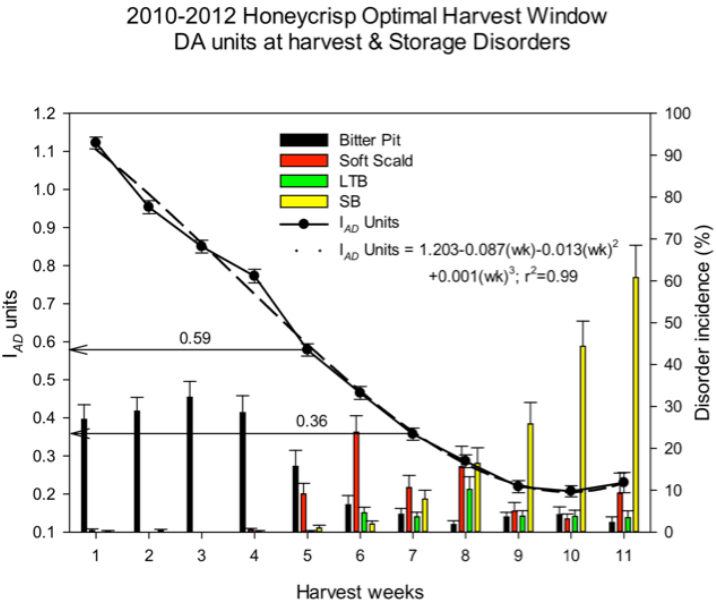Avoid early harvest of late-season processing apple varieties to reduce economic losses caused by bitter pit
A discussion of the impact of apple harvest timing on post-harvest disorders, including bitter pit.

Harvest is a stressful time for farmers who are trying to manage harvesting varieties in an order that maximizes the efficiency of their operations. While finishing a variety early can be an appealing thought to many growers, rushing harvest can result in significant economic loss due to bitter pit and other post-harvest disorders while fruit are in storage. Bitter pit is a physiological disorder attributed to calcium deficiency within the fruit that is commonly caused by excessive tree vigor or a small crop. A lesser known cause of bitter pit is premature harvest and storage of fruit.
While most growers associate bitter pit with Honeycrisp, premature harvest can increase incidence of bitter pit in any apple variety. Unlike other incidences of bitter pit that appear during the growing season, bitter pit caused by premature harvest of fruit will not be observed until apples are pulled out of storage. This makes it possible for growers to rush harvest of a variety, put perfect-looking fruit in bins and then take a hit on quality grades when fruit come out of storage several months later.
Mutsu/Crispin and Northern Spy are later-season processing apples that have been frequently harvested well in advance of physiological maturity over the past several years in west central Michigan. Mutsu/Crispin and Northern Spy are considered ready for controlled atmosphere (CA) storage at a starch index of at least 3.0 and fruit firmness between 16 and 18 pounds, depending on desired length of CA storage. These varieties do not tend to reach maturity until mid- to late October in a typical west central Michigan growing season.
Despite this, many orchards of Mutsu/Crispin and Northern Spy included in the Michigan State University Extension Apple Maturity Program were harvested before the end of September in 2017 and 2018. Some were harvested as early as the third week of September. In many cases, these varieties were commonly harvested three to four weeks earlier throughout the region.
The impact of this practice has shown up in recent years as fruit has come out of storage and been graded. Reports of bitter pit in Mutsu/Crispin and Northern Spy coming out of local storage facilities have been on the rise in the past several years. This has caused economic losses for growers and processors.
|
Table 1. Regional summary data for Mutsu/Crispin, west central Michigan, 2018 | |||
|---|---|---|---|
|
Sample date |
Firmness lbs. (range) |
Starch index (range) |
Brix % (range) |
|
Sept. 17 |
18.15 (17-20.5) |
2 |
11.02 (10-12.5) |
|
Sept. 24 |
16.64 (14.8-17.6) |
2.1 (2-3) |
10.94 (11-13) |
|
Oct. 1 |
16.11 (13.9-20.8) |
1.7 (1-2) |
11.27 (11.3-13.3) |
|
Oct. 8 |
15.73 (14-18.8) |
2.7 (2-2) |
12.47 (12.2-13.5) |
|
Oct. 15 |
13.675 (10.3-15.9) |
3.9 (2-7) |
12.34 (11-13.4) |
Maturity data collected by MSU Extension’s Apple Maturity Program demonstrated the lateness of maturity of Mutsu/Crispin in 2018. While fruit did start to get soft, starch index indicated fruit did not reach maturity at the tested locations until the Oct. 15 test date (Table 1). Northern Spy demonstrated a similar progression of maturity in 2017 and 2018.

Previous work has shown that bitter pit in storage can increase by as much as four-fold when fruits are harvested a month early (Fig. 1). This is generally true of most apple varieties when harvest is rushed. Mutsu/Crispin and Northern Spy are late-season apples and will develop severe bitter pit if harvested too soon. Immature fruit cannot be cured of the disorder and there is no way for a processor or CA storage owner to help with the pack-out of a grower who is affected by this issue. Growers will see better returns on a higher quality fruit if the harvest window of these varieties is moved so that the fruit is physiologically mature at time of harvest. Weekly testing of fruit and delaying harvest will improve performance of these varieties and lead to better profit for growers.



 Print
Print Email
Email